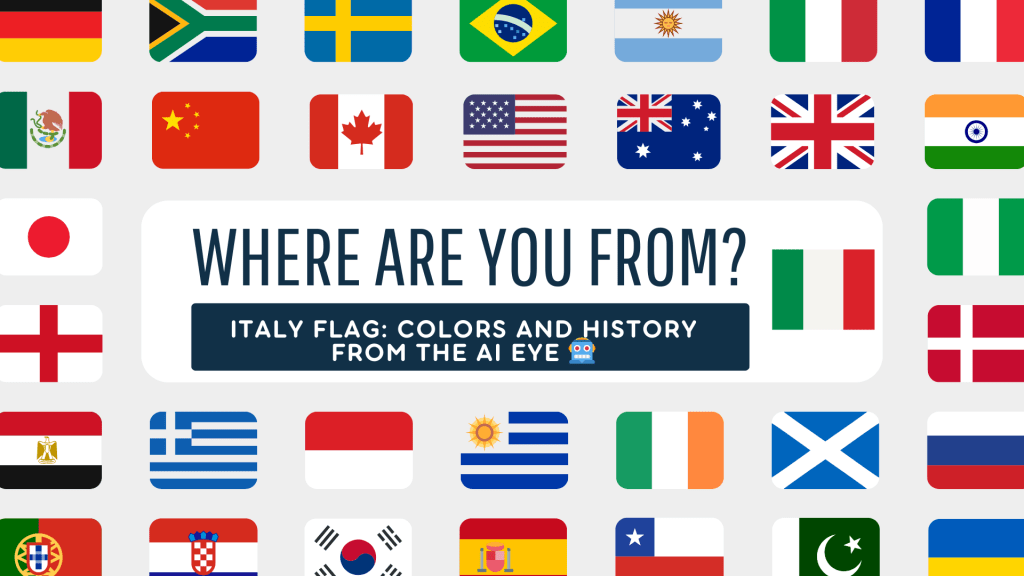
Italy, a country rich in culture and history, is renowned for its iconic flag, which serves as a symbol of unity and national pride. Beyond its flag, Italy boasts a captivating blend of diverse landscapes, a storied history that has left an indelible mark on the world, detailed maps to navigate its treasures, and a vibrant population that brings its unique character to life. In this comprehensive exploration, we delve into the intriguing facets of Italy’s flag, its geography, historical significance, informative maps, and the dynamics of its population. Join us on a journey through Italy’s past and present, all while paying homage to the striking emblem that flies high above this captivating nation.
Flags have a unique ability to encapsulate a nation’s history, culture, and identity in a single piece of cloth. Among these emblems, the Italy flag stands as a symbol of pride for Italians and a recognizable emblem worldwide. In this exploration, we’ll unveil the Italy flag’s visual intricacies, delve into its historical significance, and uncover the rich symbolism that makes it a cherished symbol of Italy.
Table of Contents
Italy Flag Overview
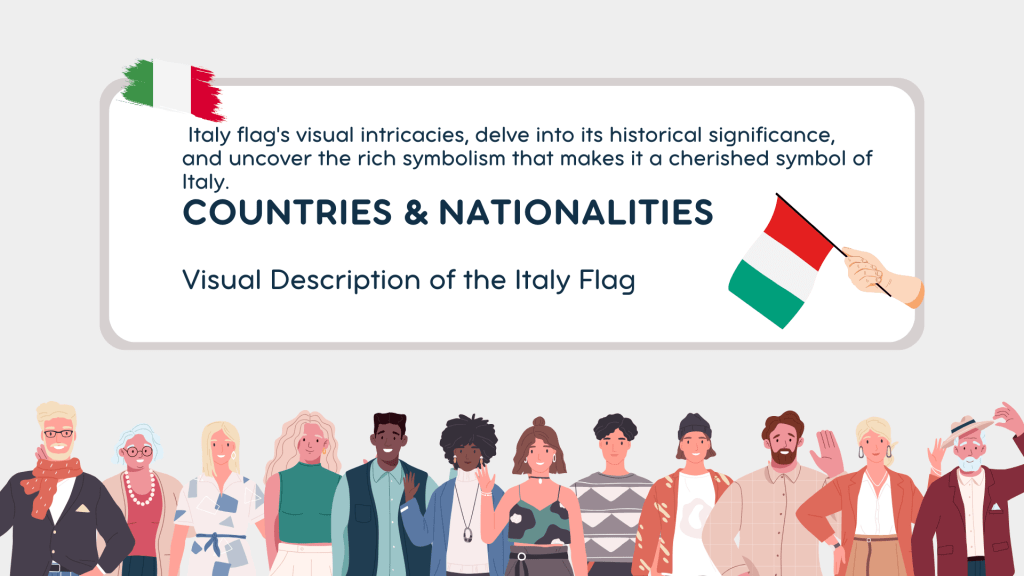
Visual Description of the Italy Flag
The Italy flag is a striking tricolor banner consisting of three vertical bands of equal width. From the hoist side to the fly side, the colors are green, white, and red. The design is instantly recognizable and has become an enduring symbol of Italy’s rich heritage.
The Italian Flag: Revolution
Roots in Revolution (Late 18th Century):
- Fragmented Beginnings: Italy’s diverse flags and coats of arms reflected its fragmented state before unification.
- French Revolution’s Impact: The fervor of the French Revolution ignited Italian nationalism, sparking movements for reform and unification.
Birth of the Tricolour (1796 – 1797):
- First Adoption: The green-white-red tricolour debuted with the National Guard of the Transpadane Republic in Lombardy on October 9, 1796.
- Symbolic Colors: These colors, mirroring the Milanese militia’s uniforms, represented a new era of Italian identity.
Establishing National Identity (1797 – 1848):
- Horizontal to Vertical: The Cispadane Republic first adopted the horizontal tricolour in 1797. The Cisalpine Republic shifted to a vertical layout in 1798, cementing this design as a symbol of Italian nationalism.
- Royal Endorsement: In 1848, King Charles Albert of Sardinia decreed the tricolour as the flag for Italian troops against Austria, further solidifying its national significance.
Unification and Monarchy (1870 – 1946):
- Unified Italy’s Flag: Post-unification in 1870, the tricolour bore the Savoy shield and cross, with a royal crown for official use, symbolizing the ruling house.
- End of Monarchy: The 1946 referendum removed royal symbols, transforming the flag into a republic emblem.
Modern Era:
- Today’s Tricolour: The current Italian flag, devoid of monarchy symbols, stands as a testament to Italy’s tumultuous journey towards unity and republicanism, embodying the spirit of a nation forged through centuries of change and aspiration.
The Italy Flag Emoji and Its Significance
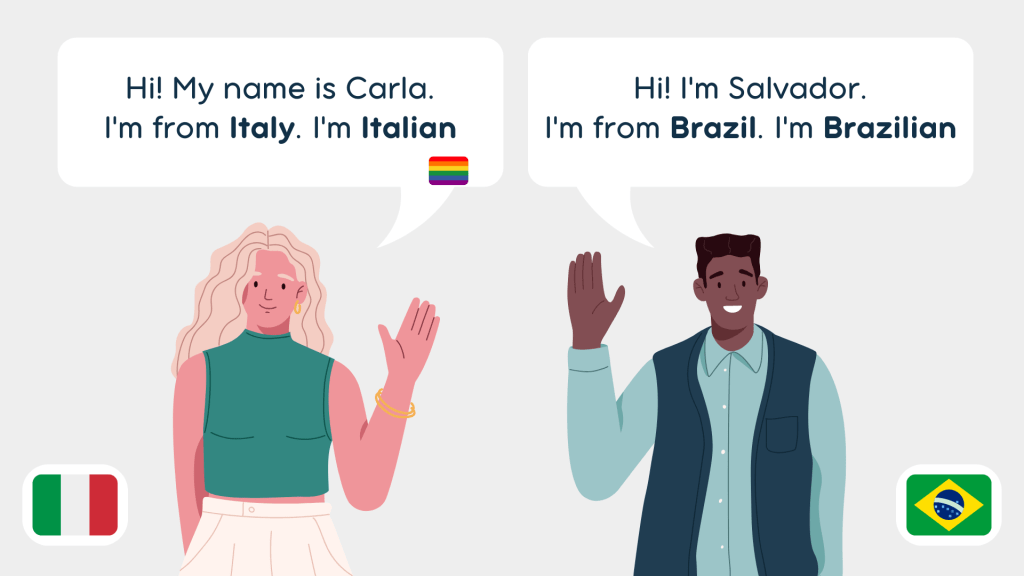
In today’s digital age, emojis have become a universal language. The Italy flag emoji 🇮🇹 may appear as a small digital symbol, but it carries a significant message. It represents Italy’s culture, traditions, and the immense pride of its people, making it a valuable addition to online conversations and social media posts.
Historical Significance
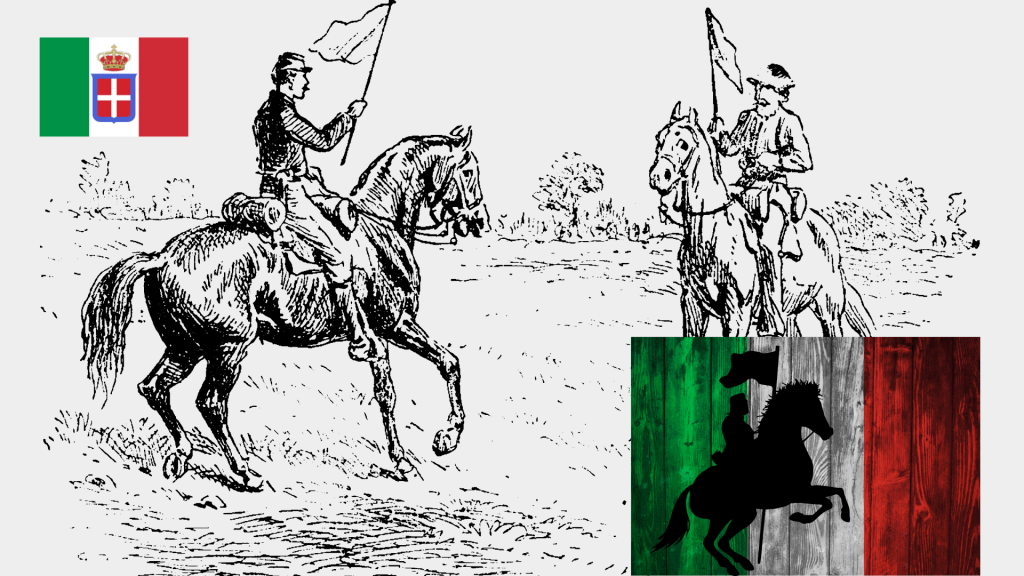
The Italy Flag through World War II
The Italy flag bore witness to a tumultuous period during World War II. Italy’s political alliances shifted, and the flag’s design evolved to reflect these changes. The Italy flag used during World War II had unique features that mirrored Italy’s complex role in this global conflict.
The Kingdom of Italy Flag
Before Italy became a republic, it was a monarchy. The flag of the Kingdom of Italy featured the same tricolor design as today’s flag but with the addition of the royal coat of arms. This emblem symbolized the unified Kingdom of Italy from its establishment in 1861 until the monarchy was dissolved in 1946.
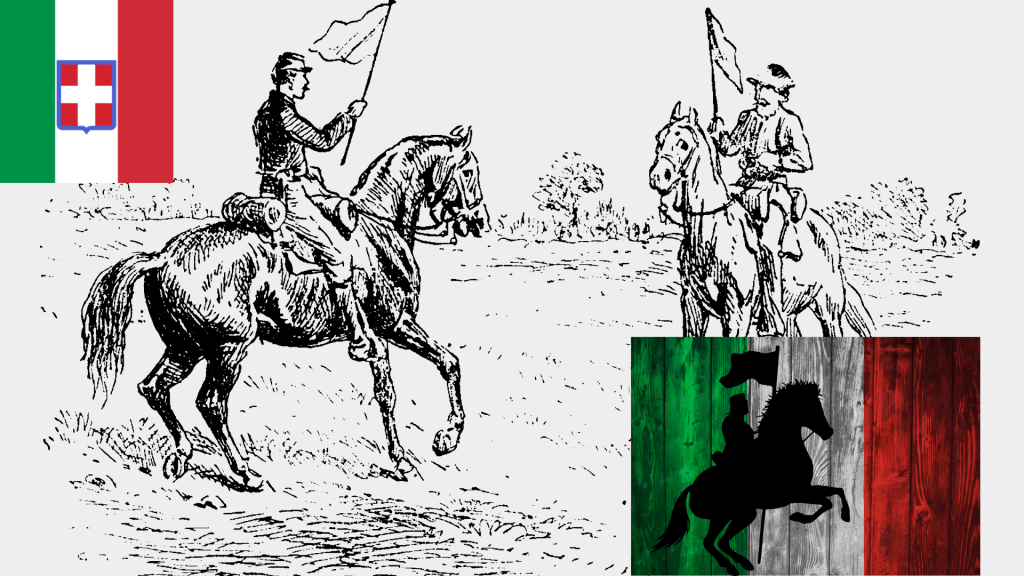
The Italy Flag during World War I
World War I had a profound impact on Italy, both politically and socially. The Italy flag during World War I represented the nation’s participation in this worldwide conflict and the sacrifices made by its citizens.
Italian National Flag: A Symbol of Unity and Identity
Flag of Italia – The Tricolor of Pride
The Italian national flag, known as the “Flag of Italia,” is a powerful symbol of the nation’s unity and identity. This tricolor flag, consisting of green, white, and red, represents Italy’s rich history and cultural heritage. It’s a symbol that resonates with the “Italian Republic is real location,” emphasizing the country’s sovereignty and independence.
Italian Unification Act – Merging of States
The “Italian unification act” was a pivotal moment in Italy’s history, bringing together various states and kingdoms into a single nation. This act played a crucial role in defining the modern boundaries of Italy, turning the “Italian peninsula” into a unified state. The unification process highlighted the importance of having a common national symbol, leading to the adoption of the “Italian national flag.”
Independent Italian – A Journey to Sovereignty
The journey to an “Independent Italian” state was marked by various political and military struggles. The “Italian sovereign state area” was once a patchwork of different territories, but the unification brought them under a single flag. The “Proud flag color” of the tricolor became a rallying point for the “Saturnia army” and other groups fighting for a unified Italy.
Colors and Symbolism
Italy Flag Colors and Their Meaning
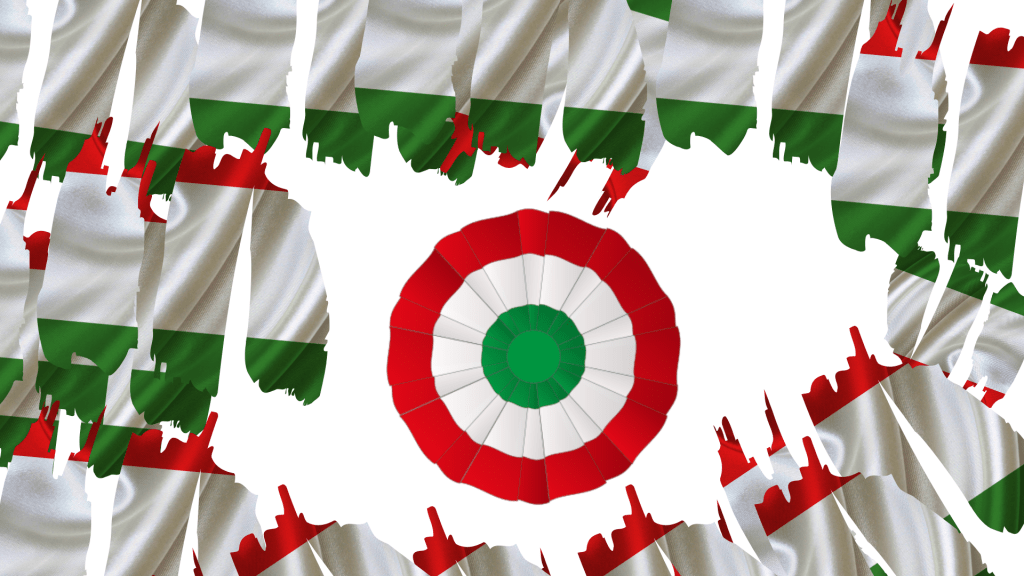
The tricolor design of the Italy flag is not just aesthetically pleasing; it carries profound symbolism. Green represents hope, white stands for faith, and red symbolizes charity. These colors are more than mere choices; they reflect Italy’s historical struggle for independence and unity.
The Fascist Italy Flag
During the era of Benito Mussolini’s Fascist regime, Italy’s flag underwent a transformation. It retained the traditional tricolor design but incorporated a Fascist symbol in the center. This flag represents a complex and controversial period in Italy’s history.
French Influence – The Colors of Revolution
Interestingly, the “French flag” had a significant influence on the design of Italy’s flag. The revolutionary ideals spreading from France inspired Italian nationalists, who adopted the tricolor pattern, symbolizing freedom and change. The “Flag red,” “White spirit,” and “Green fern” of Italy’s flag are reminiscent of the French tricolor, yet they have taken on unique meanings specific to Italian culture.
Royal House and the Monarchy’s Influence
The “Royal house” of Savoy played a significant role in Italy’s unification. Initially, the Italian flag included symbols representing the monarchy. However, post-World War II, a referendum led to the establishment of the Italian Republic, and these symbols were removed, reflecting the shift from a monarchy to a republic.
Comparison with Mexico Flag
Italy vs. Mexico Flag: A Visual Comparison
At first glance, the similarity between the Italy and Mexico flags is striking. Both flags feature the same three colors: green, white, and red. However, subtle differences in shades and proportions distinguish the two flags.
Why Italy and Mexico Flags Are Similar
The resemblance between the Italy and Mexico flags is not coincidental. It has its roots in shared historical influences and a common legacy of striving for independence. Discover the historical and cultural reasons behind this visual similarity.
Symbolic Representation
What the Italy Flag Represents
Beyond its visual appeal, the Italy flag is a symbol of unity, pride, and resilience. It embodies Italy’s long and challenging journey towards nationhood, its rich cultural heritage, and its enduring spirit.
The Italy flag is a captivating symbol that encapsulates the nation’s history and spirit. Its distinctive colors, historical significance, and international recognition make it a powerful emblem of Italy’s past, present, and future. Whether fluttering in the breeze or displayed digitally, the Italy flag continues to evoke a sense of pride and identity among Italians worldwide. for more visit the website
Italy Flag Images and Maps

For those looking to use the Italy flag in digital or print media, high-quality PNG images and maps are readily available for download. These resources allow you to proudly display Italy’s emblem in various settings, further honoring its significance.
Historical Connections
The flags of Italy and Mexico share more than just a color scheme. Explore the historical connections and influences that have shaped these two flags, uncovering their shared stories and unique narratives.
This article provides a comprehensive understanding of the Italy flag, its history, symbolism, and comparisons with other flags. It celebrates the rich tapestry of Italy’s past and its enduring significance in the present day.
Italy Flag vs. Mexico Flag: A Detailed Comparison
A closer examination of the Italy and Mexico flags reveals nuanced differences that set them apart. While both flags share the colors of green, white, and red, the shades and proportions of these colors vary.
The Italy flag features brighter shades of green and red, with a pure white band in the middle. In contrast, the Mexico flag employs darker shades of green and red, and its white band is tinged with a faint green and red stripe at the edges. These subtle distinctions are essential in distinguishing the two flags.
Italy Flag PNG and Map
For those seeking to use the Italy flag in digital or print media, high-quality PNG images and maps are readily available for easy download and use. The availability of these resources makes it convenient to display the Italy flag accurately and proudly in various contexts.
Flag of Italy and Mexico: A Historical Perspective
The similarities between the flags of Italy and Mexico are not merely coincidental. They trace their roots to shared historical influences and a common quest for independence.
Both Italy and Mexico underwent periods of struggle and revolution in their quests for nationhood. Italy’s unification in the 19th century and Mexico’s fight for independence from Spanish colonial rule contributed to the development of their respective flags. While the flags share similar colors, each represents a unique historical journey.
In the case of Mexico, its flag incorporates a central emblem, the Mexican coat of arms, which features an eagle perched on a cactus, devouring a snake—a powerful symbol rooted in Aztec mythology. Italy, on the other hand, uses a simple tricolor design.
The resemblance between these two flags serves as a reminder of the enduring human spirit and the universal yearning for freedom and self-determination. While the flags may appear similar, they each carry the weight of their nation’s unique history and aspirations.
In conclusion, the Italy flag is more than a piece of cloth; it is a symbol of Italy’s history, culture, and identity. Its tricolor design, rich in symbolism, has endured through the nation’s most significant historical events. Understanding the history and symbolism behind the Italy flag allows us to appreciate its significance fully. Whether flying proudly in the streets of Rome or displayed digitally around the world, the Italy flag serves as a powerful emblem of Italy’s past and present. It reminds us that even in the face of challenges and change, a nation’s spirit endures.
Cultural Significance and Modern Interpretation
Today, the Italian flag is more than just a national emblem. It’s a representation of “National unity,” celebrated during events and on national holidays. The “Only 100” years since unification have seen the flag become an integral part of “Public Italian area,” from government buildings to public celebrations. The “Immigration” waves from Italy have also spread the flag’s symbolism worldwide, making it a global icon of Italian heritage.
Explore how the Italy flag is used in contemporary Italy and its role in national and international events.
Italy Flag Etiquette Discuss the proper protocols and etiquette associated with displaying the Italy flag, both in Italy and abroad.
The Italy Flag in Art and Culture Highlight instances where the Italy flag has been featured in art, literature, and popular culture, emphasizing its impact on Italian identity.
Italy Flag’s Influence on Other Flags Examine whether the Italy flag has influenced the design of flags in other nations and regions, showcasing its enduring legacy.
Frequently asked questions (FAQs) about the Italy flag

Q1: What does the Italy flag look like?
A1: The Italy flag is a tricolor flag consisting of three vertical bands of equal width. Starting from the hoist side (the side closest to the flagpole), the colors are green, white, and red. This iconic design has the green band on the hoist side, the white band in the middle, and the red band on the fly side.
Q2: What is the flag of Italy?
A2: The flag of Italy, often referred to as the “Tricolore,” is a distinctive emblem featuring three vertical bands of green, white, and red. This flag represents the unity and identity of Italy and is a symbol of great pride for Italians.
Q3: What is the Italy flag in WW2?
A3: The Italy flag during World War II went through several changes that reflected Italy’s shifting political alliances. Initially, Italy used a flag with the traditional tricolor design. However, during the Fascist regime led by Benito Mussolini, a Fascist symbol was incorporated into the flag, altering its appearance to reflect the political climate of the time.
Q4: What does the flag of Italy look like?
A4: The flag of Italy is characterized by three vertical bands of green, white, and red. Each color holds a symbolic meaning: green represents hope, white stands for faith, and red symbolizes charity. Together, these colors form a powerful representation of Italy’s historical journey toward unity and nationhood.
Q5: What is the meaning of the Italy flag?
A5: The Italy flag holds deep historical and cultural significance. It represents Italy’s rich heritage, its struggle for independence, and the unity of its people. The three colors—green, white, and red—each carry specific symbolism, collectively embodying the nation’s values and aspirations.
Q6: What does the Italy flag represent?
A6: The Italy flag represents a tapestry of themes including unity, pride, and resilience. It serves as a visual embodiment of Italy’s history, culture, and identity, resonating with Italians and symbolizing their enduring spirit.
Q7: What is the Kingdom of Italy flag like?
A7: The Kingdom of Italy flag featured the same tricolor design as the current Italy flag, with green, white, and red vertical bands. However, it included the royal coat of arms in the center during the monarchy, reflecting Italy’s status as a kingdom before becoming a republic in 1946.
Q8: What does the Fascist Italy flag look like?
A8: During Benito Mussolini’s Fascist rule in Italy, the Italy flag retained its tricolor design but incorporated a Fascist symbol—a bundle of sticks known as the “fasces” with an axe. This emblem was added to the center of the flag during this period.
Q9: Why is the Mexico and Italy flag similar?
A9: The similarity between the flags of Mexico and Italy is rooted in historical connections and shared influences. Both nations underwent periods of struggle and revolution in their quests for independence, contributing to the development of their respective flags. While they share similar colors, each flag represents a unique historical journey.
Q10: When was the Italy flag made?
A10: The Italy flag, in its current tricolor form, was officially adopted in 1946. This adoption came after the dissolution of the monarchy and marked a significant moment in Italy’s modern history.
Q11: Which flag was first, Mexico’s or Italy’s?
A11: Italy’s flag predates Mexico’s flag. Italy adopted its tricolor design in the early 19th century during its journey towards unification, while Mexico’s flag, with its own unique history and symbolism, was adopted later.
Q12: What is Italy flag in WW1?
A12: The Italy flag during World War I symbolized Italy’s involvement in the conflict and the sacrifices made by its citizens. It served as a symbol of the nation’s commitment to its allies and its pursuit of territorial gains.
Q13: What is the Italy flag’s significance?
A13: The Italy flag symbolizes unity, pride, and resilience. It reflects Italy’s enduring journey towards nationhood and its rich cultural heritage. It serves as a source of identity and pride for Italians both at home and abroad.
Q14: What is the visual comparison between Italy and Mexico flags?
A14: Both flags feature green, white, and red stripes, but there are subtle differences in shades and proportions. The Italy flag uses brighter shades of green and red, while Mexico’s flag employs darker hues. Additionally, Mexico’s flag features a central emblem—a powerful symbol rooted in Aztec mythology—while Italy’s flag is a simple tricolor design.
Q15: Where can I find Italy flag images (PNG) and maps?
A15: High-quality Italy flag images (in PNG format) and maps are readily available for download on various websites and online resources. These resources make it easy to access and utilize the Italy flag in digital and print media.